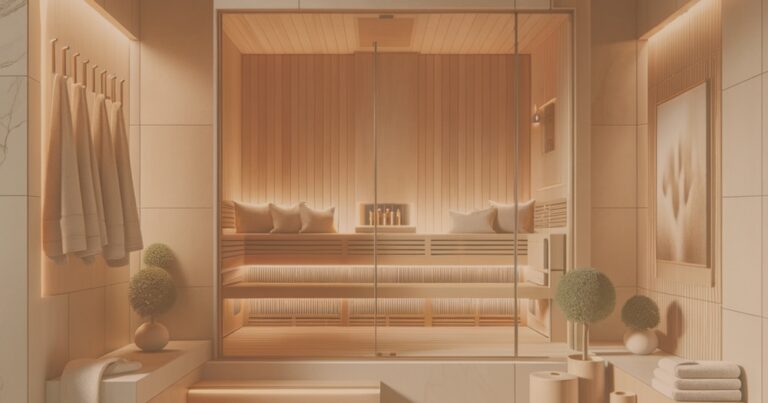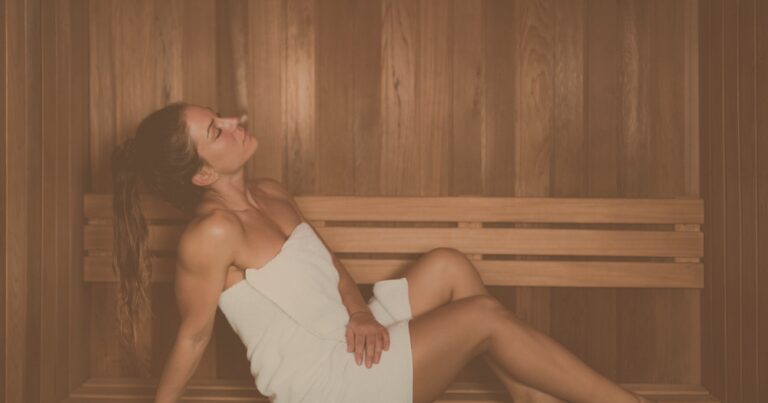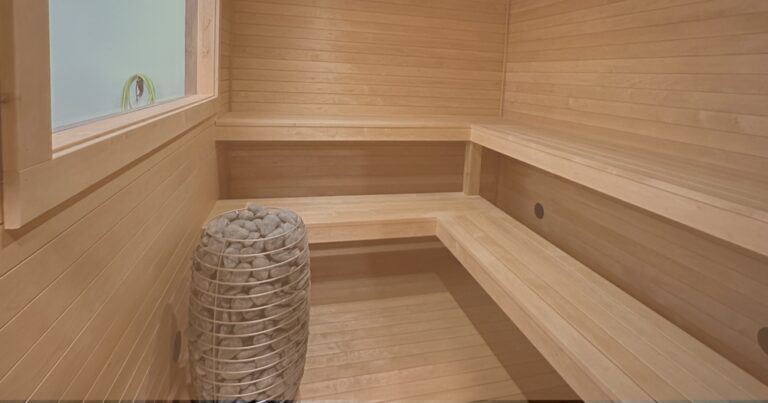Planning to build or purchase a sauna?
Before you do, take time to consider your wood selection process. Due to high heat intensity and humidity cycles, selecting the right wood for your sauna is critical.
The best sauna wood would ensure that your sauna is durable, resistant to heat and water, and has or can maintain the aesthetic appeal you desire.
To help you choose the right type of wood for your sauna construction, this article will discuss in detail factors you should consider in your wood selection process, the best wood suitable for building saunas, and the importance of choosing the right wood for your sauna.
Factors to consider when selecting a Sauna Wood
When selecting wood for the construction of your sauna, there are specific considerations you need to keep in mind if you desire to make the right choice.
Here, we will discuss the most important factors to consider when selecting a Sauna Wood.
1. Water resistance
Since woods will be exposed to intense heat and humidity cycles, sauna wood is susceptible to mold development and decay, especially if it is a traditional sauna. Hence, you must select a naturally decay and water-resistant wood if you want to build a sauna that will last for a long time.
If you use the wrong type of wood, you risk building a sauna susceptible to mold development and decay. You can take it a notch further by treating the wood with wood preservatives to enhance resistance.
2. Heat resistance
As mentioned earlier, sauna woods experience high heat intensity and humidity cycles. But in this case, our focus is on temperature. The wood you choose has to be heat resistant.
If you end up picking a wood that isn’t, an expansion that leads to cracks will occur, impacting the looks of your sauna.
3. Durability
A sauna room constantly goes through cycles of heating and cooling phases. Therefore, when constructing a sauna, select a wood quality that can withstand these cycles without warping, expanding, shrinking, or cracking.
If you are not deliberate in your selection process, you’ll be disappointed when it starts deteriorating, and replacement can be costly.
4. Cool to Touch
Due to the high-intensity heat produced in a sauna, finding a wood type that will remain cool even when the temperature rises is vital. If you fail to account for this crucial factor, your experience may end differently than expected!
When improper wood (Hardwoods) is used in a Sauna, the temperature inside might become excessively hot, dangerous, or uncomfortable.
On the other hand, softwoods radiate less heat than hardwoods. Hence, they are widely used.
5. Scent
Although some people like scented woods, others do not, as they may be sensitive to the smell or even allergic to the phenols in wood that produce the scent; as a result, more neutral woods are preferable options.
Before you choose the wood for your sauna, consider the kind of fragrance it emits, and if you like it, make your selection appropriately!
6. Lack of knots and saps
Inspect your chosen wood for saps and knots. While knotty wood can be utilized in paneling portions of your sauna that you do not have contact with, it can impact the aesthetic appeal of your sauna.
Knots should be avoided on seats in particular since they can cause skin rashes.
Also, ensure that your wood choice does not include sap, which might melt in the heat and impair the sauna’s structure.
7. Wood toxicity
Sauna users desire to detoxify their bodies. Some woods contain toxins and may be introduced into the environment if used to build a sauna.
Therefore, in your selection, make sure you choose a wood type with little to no toxins.
To save yourself the stress that comes with selecting the wrong wood for your sauna, contact Nordak Sauna Co to design and install the best sauna for you with the right wood.
What are the best woods for a sauna?
Now that you know the factors to consider in your selection for sauna wood, you know the best wood will be resistant to mold, provide thermal comfort, and showcase the natural beauty of a wood product.
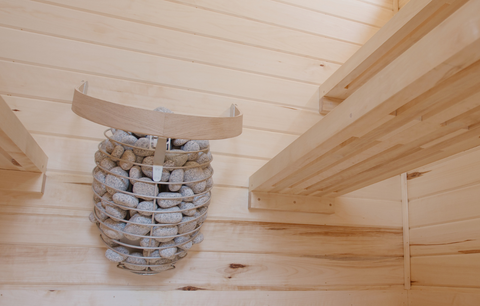
Here are the best woods to provide these desirable traits for your sauna:
Western red cedar
One of the most preferred choices for making traditional and infrared saunas. Western red cedar is softwood with a natural resistance to moisture & temperature fluctuations. Hence, it is less likely to crack or expand under high temperatures.
Cedar is colorful and naturally beautiful, which is an added advantage for the aesthetics of your sauna.
Since it can resist heat, Cedarwood allows heat to flow uniformly through the sauna while keeping the surface cool.
Besides being heat-resistant, cedar has a naturally appealing smell that adds to the aromatherapy in your sauna.
It is a fungus, decay-resistant, and durable; hence, you can be sure of a sauna that will last you for a long time.
Redwood
Redwood is identical to western red cedar. It is a softwood and is resistant to high heat. As the name suggests, the wood is a stunning red color that will give your sauna a distinct appearance.
Redwood is resistant to mold, fungi, and rot. However, just like cedar wood, it is essential to mention the few drawbacks of redwood.
For starters, the color of redwood fades with time. The red hues will degrade and turn greyish after a few months of use.
Secondly, newly installed redwood saunas emit red colors, which can blend with your sweat and turn your body red.
Western hemlock
Western hemlock does not have as many advantages as western red cedar, but its endurance and distinct pattern make it an excellent sauna wood.
This wood works best when combined with other woods to create a complete sauna solution.
For example, western red cedar can be used for the interior and exterior of your sauna, while hemlock can be used for the seats and doors.
Remember that western hemlock expands slightly and is less rot-resistant than the other alternatives on the list.
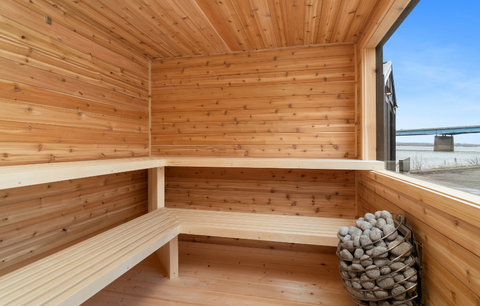
Nordic spruce
Nordic spruce, also known as Norway spruce or European spruce, is a tree that grows in Northern, Eastern, and Central Europe. Because of its density and firmly ingrown form, it is a popular choice for a sauna.
Regarding looks, Nordic spruce is a light-colored wood that stays the same throughout its life. It also has an agreeable scent and natural insect-repelling properties.
However, Nordic spruce contains little sap that varies from board to board. As a result, make sure you inspect the wood for the same.
Common aspen
Aspen is another remarkable wood that is widely used in the construction of saunas. It has a vibrant hue and can be found in colder parts of Europe, Asia, and Northern Russia.
Aspen is non-toxic, non-allergenic, resin-free, and moisture-resistant by nature, making it an excellent choice for saunas. Aspen is also fungal and bacterium-resistant, making it a safe choice of wood.
Because of its distinct light tone and patterns, common aspen can offer your sauna an aesthetically appealing look.
Alaskan yellow cedar
Alaskan yellow cedar isn’t actually cedar but rather a type of Cypress tree once used by western Native Americans to fashion totem poles.
Alaskan yellow cedar is highly resistant to fungus and decay. It is often chosen for hot tubs, saunas, and pools simply for its appearance – an attractive yellow color.
Alaskan yellow cedar also gives off a subtle scent that can add to the sauna’s therapeutic effects.
Since it grows in humid climates, Alaskan yellow cedar can withstand hot and moist sauna rooms. It is lightweight but thick enough to allow for intricate construction.
Basswood
If you have delicate skin, basswood is the best choice for you. It is light brown and has natural antifungal properties. It is also softwood, which means it is a durable sauna wood option that will perform well under high temperatures.
Basswood emits no smell or toxins and has little to no knots. It is soft to the touch and resistant to expansion and cracks.
One of the best things about choosing basswood is that it is affordable and accessible.
Douglas fir
Although not a true fir, Douglas fir is highly valued for its durability, strength, and looks. Thanks to its ornamental look, the wood is commonly used in making Christmas trees.
Douglas fir offers your indoor and outdoor saunas a beautiful, consistent appearance. It has antifungal and rot-resistant properties and emits little to no smell.
Pine
Pine is the most reasonably priced wood for building saunas. Most pine trees yield darker-colored wood identical to spruce, except they tend to have more knots.
Knots aren’t usually a problem, but some pine species tend to be large and have loose knots.
These knots may dry and fall out, particularly in infrared saunas. As a result, they are not a popular choice for infrared saunas.
If you use pine to build a sauna, save it for the portions you won’t be touching.
When thermally treated, pine transforms into a whole other type of wood: firmer, denser, and more stable. As a result, ensure that the pine you choose for your sauna is kiln-dried or is a thermally treated wood.
You may also like: Comparing Traditional and Infrared Saunas.
Eucalyptus
Eucalyptus is a fast-growing, aromatic, suitable softwood choice for saunas. The wood is insect- and rot-resistant, comes in various colors, and changes color as it fades.
It has a beautiful, uncommon look that can give your sauna a distinct personality. The only reason it is rarely used in building saunas is because of its cost.
Exploring Thermally Modified Woods: Benefits and Varieties for Saunas
Thermally-modified wood, sometimes referred to as thermally treated wood, stands out as an exceptional building material with a multitude of applications, including saunas, decking, and exterior cladding. This innovative technology draws inspiration from a centuries-old Nordic tradition of treating wood with fire, evolving into a modern marvel exemplified by Thermory. The process involves subjecting the wood to meticulously controlled temperatures of up to 420 degrees Fahrenheit within specialized thermokilns, effectively reducing its equilibrium moisture content while enhancing its natural qualities. This results in wood that boasts outstanding dimensional stability, resisting the effects of humidity and moisture, and displays increased resistance to heat, mold, and mildew. Furthermore, thermal modification enhances the wood’s aesthetics, giving it a beautifully deep and even tone. Among Thermory’s selection of thermally-modified woods, the Magnolia, Aspen, Spruce, and Alder each bring their unique characteristics to various applications, making them ideal choices for those seeking both performance and beauty in their wood projects.
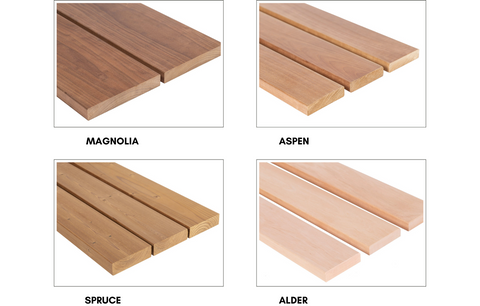
Magnolia
Thermally Modified Magnolia wood is prized for its exceptional durability, ensuring that it can withstand the high temperatures and moisture levels typically found in saunas.
Aspen
Thermally Modified Aspen wood’s natural resistance to warping and stability make it an excellent choice for saunas, ensuring the longevity of your sauna structure.Spruce:
Spruce
Thermally Modified Spruce wood’s clean and uniform grain pattern gives saunas a classic and timeless appearance, enhancing the overall aesthetics of the space.
Alder
Thermally Modified Alder wood’s rich, reddish-brown hue adds a sense of luxury and warmth to sauna interiors, creating a cozy and inviting atmosphere.
Importance of Choosing the right sauna wood
Here are some of the reasons why choosing the right sauna wood is essential:
To create an unmatched aesthetic appeal
Regarding sauna room aesthetics, no material can make your sauna more exquisite than wood. You can design a sauna with the right wood to match your desired style regardless of your steam sauna bath’s decor.
To tolerate intense heat
The average duration of a sauna session is 30 minutes, coupled with the fact that a sauna enclosure can get so hot, with temperatures ranging between 150 degrees Fahrenheit and 200 degrees Fahrenheit.
Under such intense heat, some woods are susceptible to heat and would expand and crack. Some would change colors, and as they absorb heat, they can burn your skin.
But the right sauna wood will not break in such intense heat conditions. And, even if you’re seated on the sauna bench with little clothing or leaning against the sauna wall, your skin is less likely to suffer a burn as it remains cool to touch even under such a high temperature.
To tolerate moisture
Despite the fact that there are several sauna types, they can be split into two categories depending on the thermal conditions they produce: dry saunas and wet saunas.
Heat is generated in a dry sauna by warming volcanic rocks. As a result, humidity and moisture levels in such saunas are low.
However, this is not the case with a typical wet sauna, which generates heat by pouring hot water on sauna stones. As a result, excessively wet and humid sauna enclosures are frequent in such saunas.
Apart from the capability to withstand extreme heat, the right wood can withstand wetness in a wet sauna without affecting its quality or longevity.
To provide natural aromatherapy
If you are the type that often visits a sauna, you know that the proper aroma in a sauna bath is just as vital as sauna heat.
While sauna heat nurtures your body, a balanced and calming aroma works wonders to restore your mind. Hence, this is why aromasense pumps are in high demand in saunas and steam showers.
But what if we told you that your sauna could organically produce aroma?
There are naturally aromatic woods that can scent your sauna space. For example, eastern red cedar has a distinct scent and leaves a pleasant odor in areas where it is applied.
FAQs
Here are answers to some of the most frequently asked questions concerning selecting the right wood for sauna.
Pine or cedar, which is best for a sauna?
To answer this question, we need to understand the basics of both sauna wood types and their differences.
Pine is the most reasonably priced sauna wood. So, if you’re looking for budget-friendly sauna wood, you should consider pine.
However, pine is not suitable for saunas that have exceptionally higher temperatures. It can’t resist heat as much as other woods. This means there’s a good chance it can burn your skin.
On the other hand, cedar is a more robust, heat-resistant sauna wood option and does not expand or contract as much as other woods when the temperature changes. That said, cedar is a better option for a long-lasting sauna.
What type of wood is the least toxic for a sauna?
As we have established, many good kinds of wood can be used to construct your sauna; however, each has unique properties that set them apart. Some of these woods may contain little to zero toxins in them.
If you are concerned about toxic levels of your preferred wood choice, consider basswood, common aspen, and western red cedar, which are known to be toxin-free.
Takeaway: Choose the right sauna wood to ensure durability and great aesthetic appeal
When planning to set up a sauna, picking the right wood is the most critical part of the process, as it will impact the aroma, durability, and overall aesthetic of your sauna.
A poor wood quality will not be resistant to heat, humidity, and decay, while the best wood is resistant to mold, provides thermal comfort, and is aesthetically appealing.
As a potential sauna owner, you now know what type of wood is best for your sauna.
Alternatively, you can partner with an expert to get the best wood type that meets your budget and preferences.
Nordak Sauna Co is a leading manufacturer and supplier of traditional saunas. We create sauna experiences to connect individuals with their heritage, the natural world, and ultimately to themselves. We’d love the opportunity to help you get the perfect sauna hassle-free.


